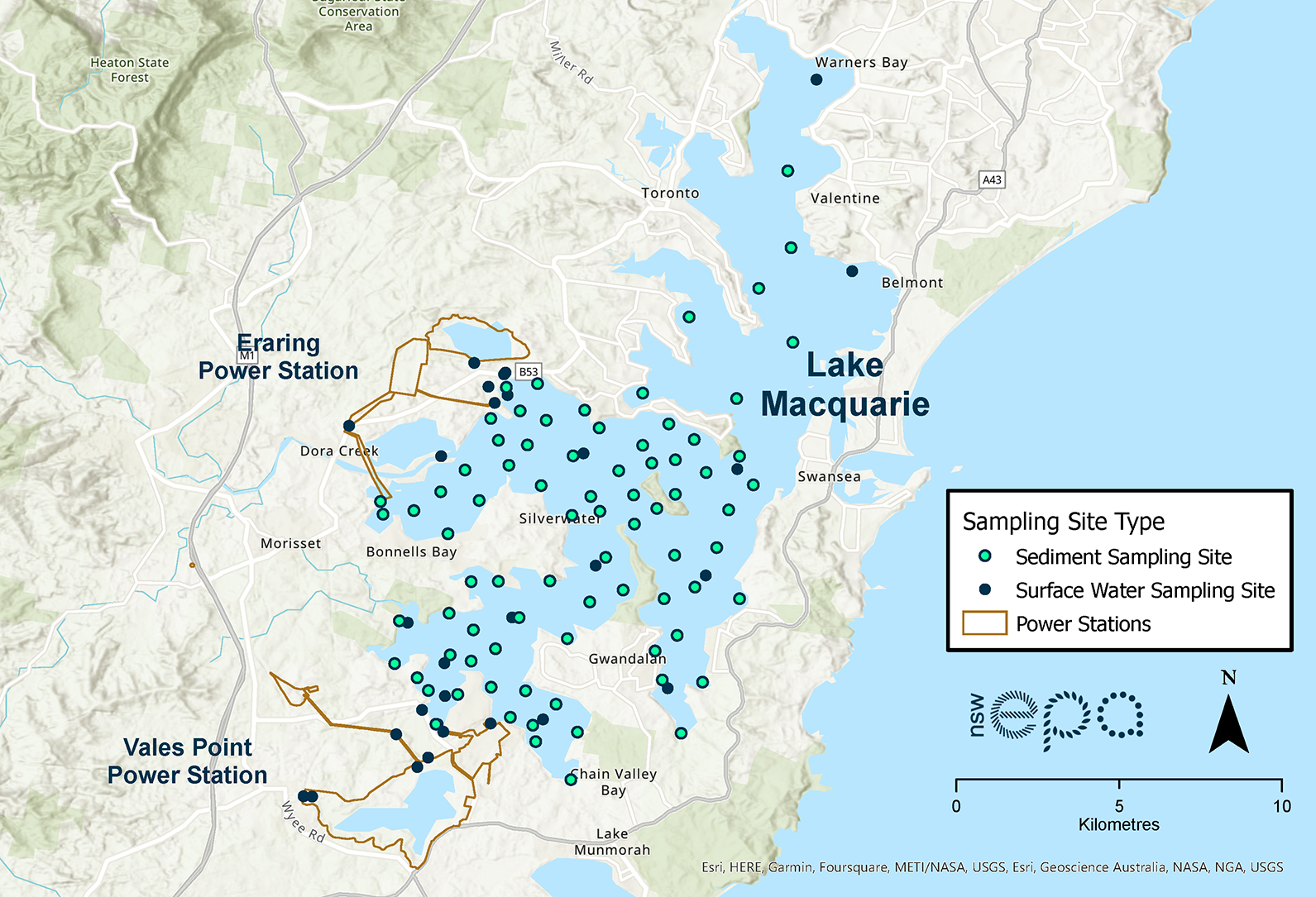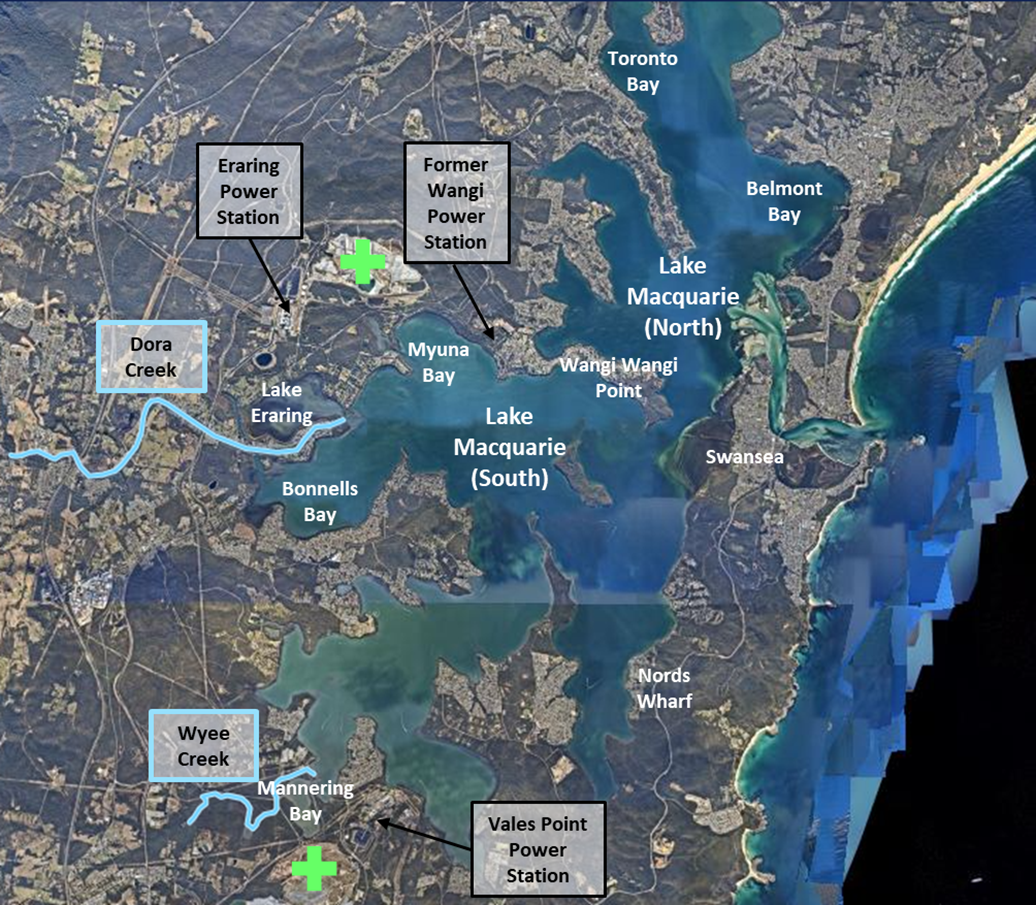Monitoring the environmental condition of Lake Macquarie
We monitored the environmental conditions near power stations in Lake Macquarie to assess current condition, provide a basis for comparison in the future and contribute to any future remediation activities.
What we are doing
The NSW Government response to the Public Works Committee ‘Inquiry into the costs for remediation of sites containing coal ash repositories in NSW’ committed the EPA to understanding the impacts of coal ash on the environment through its research agenda. Lake Macquarie was chosen as an initial step in the NSW Government’s response to the inquiry.
Why we monitored in Lake Macquarie
There is a long history of industrial and urban activity around Lake Macquarie. The impacts of this activity have been extensively studied by a range of government and other organisations over a long period of time.
As industry around the lake (such as power stations and coal mines) begins to transition to other activities and urban land use continues to expand, this assessment was an opportunity to establish a new baseline of information on the environmental condition of the lake in the vicinity of the power stations. The monitoring program focused on the areas in the vicinity of the power stations and assessed the current environmental condition, determined contaminant levels, and quantified impacts on Lake Macquarie’s biota.
The environmental assessment provides a robust foundation to compare future changes in environmental condition and helps inform any future remediation activities.
Read the results of the environmental assessment.
What the study involved
Sampling Lake Macquarie started in March 2022 with sampling of surface water at 29 power station and lake sites. Sampling ran for 12 months and collected around 350 water samples and more than 80 sediment samples. Wet weather events were sampled if rainfall exceed 30 mm in the previous 24 hours. Collection of surface sediment samples commenced in August 2022. Core samples were collected at representative locations based on the results of the surface sediment sample analysis. 80 surface sediment samples and 10 sediment cores were collected.
Samples were analysed for a group of analytes including 20 total/ dissolved metals, total suspended solids, and nutrients. Surface water results were screened against the Water Quality Guidelines (ANZG 2018). Analysis of surface sediment samples allow us to determine potential impacts on ecological receptors by understanding the distribution and levels of contamination in the lake. Additional surface sediment sampling was done for benthic community ecological assessment that looked at the types of invertebrates present. Sediment cores were analysed in segments to determine contamination levels over time.
Following a mid-project review it was also decided to augment our understanding of the lakes environmental condition by monitoring for eDNA (environmental DNA) and sediment deposition to understand current day inputs of potential contaminants.
The study investigated 4 key lines of scientific enquiry:
- surface water quality sampling: determining the concentration of present-day contaminant inputs
- surface sediment sampling: mapping the contaminant distribution in sediments and measuring change over time
- sediment ecotoxicity testing: determining potential risk to ecological receptors from the cumulative effects of all bioavailable contaminants
- sediment deposition: determining the concentration of potential contaminants in newly deposited sediment
- benthic ecological assessment: measuring impacts on the benthic invertebrate community and ecosystem health.
The water samples were collected to help determine the concentration of present-day contaminant inputs. Samples were analysed for the following parameters and results were screened against the Water Quality Guidelines (ANZG 2018).
| Parameter | ||
|---|---|---|
| Total metals and Dissolved metals | ||
| Silver (Ag), Aluminium (Al), Arsenic (As), Boron (B), Barium (Ba), Beryllium (Be), Cadmium (Cd), Cobalt (Co), Chromium (Cr), Copper (Cu), Iron (Fe), Lead (Pb), Manganese (Mn), Molybdenum (Mo), Nickel (Ni), Selenium (Se), Thallium (Tl), Vanadium (V), Zinc (Zn) and Mercury (Hg) | ||
| Total recoverable low-level mercury | Dissolved mercury | |
| Total suspended solids | Dissolved organic carbon | |
Nutrients | ||
NOx-Nitrogen Ammonia-Nitrogen Free Reactive Phosphorous | Total Nitrogen and Total Dissolved Nitrogen Total Phosphorous and Total Dissolved Phosphorous | |
Monthly surface water quality sampling was undertaken over a 12-month period to determine the range of ambient concentrations in receiving waters. Surface water quality samples were taken at 29 locations within Lake Macquarie. This includes the lake in the vicinity of coal ash dams, waterway discharges from the power station, and reference locations in both the southern (Nords Wharf and Swansea) and the northern (Belmont Bay and Toronto Bay) section of the lake.
Two additional sampling events specifically targeted wet weather events if more than 30 mm of rainfall occurred in the previous 24 hours. Wet weather event sampling is included to collect information about potential delivery of additional contaminants to waterways.

Surface sediments were collected from 80 sites across the lake and results were used to develop contour plots for metals/ metalloids of concern. Surface sediments were analysed for the following parameters.
| Parameter |
|---|
| Total recoverable metals: Silver (Ag), Arsenic (As), Boron (B), Barium (Ba), Beryllium (Be), Calcium (Ca), Cadmium (Cd), Cobalt (Co), Chromium (Cr), Copper (Cu), Iron (Fe), Lithium (Li), Manganese (Mn), Molybdenum (Mo), Nickel (Ni), Lead (Pb), Antimony (Sb), Selenium (Se), Tin (Sn), Strontium (Sr), Titanium (Ti), Thallium (Tl), Vanadium (V), Zinc (Zn) |
| Total mercury |
| Acid volatile sulfide and simultaneously extracted metals |
| Moisture content |
| Grain size |
| pH |
| Total organic carbon |
Surface sediments were collected from 80 sites in Lake Macquarie and from waterways leading from the power stations to the lake. Surface sediment sampling investigated contaminants that are bound to particles that may settle to the lake or riverbed where they are stored, overlayed with sediment or resuspended in the water column. Targeted core sampling was used to determine potential ecotoxicity impacts to help assess the likelihood of sediment impacts on ecological receptors. The bulk of the samples were collected in the southern end of the lake at locations in the vicinity of the coal fired power stations.
Sediment cores were collected from 10 locations and sectioned into intervals to understand changes in contaminant levels over time. The core samples were analysed for total metals, moisture content, grain size, pH, and total organic carbon.
Sediment core samples help us understand changes in sediment quality over time. The sediment depth taken will cover the period until before the operation of power stations in the lake catchment - approximately 1950. This is considered the most appropriate period for comparing changes in contaminant concentrations over time. The preliminary sites have been selected to provide representation within key areas of the southern section of the bay where secondary sampling will occur for chemical analysis.
Healthy sediments generally have a high diversity of macroinvertebrates, including species sensitive to pollutants. Unhealthy sediments generally only have a few types of hardy, pollution tolerant macroinvertebrate species.
Sampling locations for the benthic community ecological assessment were determined based on the results of the surface sediment chemical analysis. Up to 20 sites were selected and included a mix of representative locations in the southern end of the lake and reference locations were also sampled for comparison purposes. Within each of the sites, 3 replicate cores were collected (i.e., up to 60 individual cores were collected). Confounding factors such as sediment grain size, water depth and physico-chemical properties of the overlying water were also taken into consideration during site selection.
Questions
Was the monitoring comprehensive and independent?
Yes, the EPA commissioned the Department of Planning and Environment to undertake the monitoring. A monitoring plan was designed by expert water quality scientists and ecologists in the Department of Climate Change, Energy, the Environment and Water and peer reviewed by external experts. They also prepared the reports and the final synthesis report. The reports were peer reviewed by independent external experts to ensure their scientific integrity.
Were the community and stakeholders involved?
Prior to starting the project, we engaged with power stations and the Hunter Community Environment Centre (HCEC), who provided input into sampling sites selection.
What about human health impacts?
The EPA is considering risks to human health based on the results of the monitoring. NSW Health is responding to Recommendation 6 of the Inquiry and will propose health study types that are able to address the community's health concerns. NSW Health may also use the results of this assessment to determine potential human health risks.
